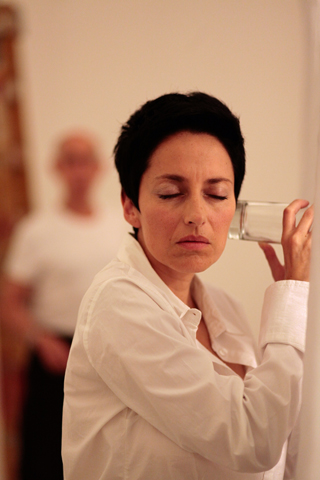
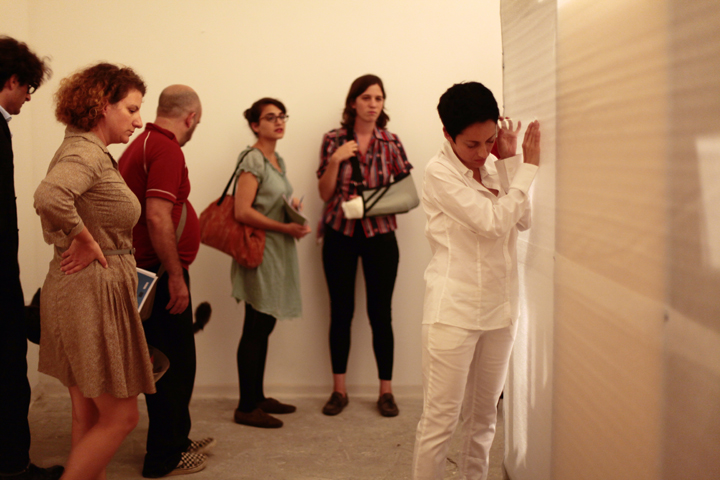
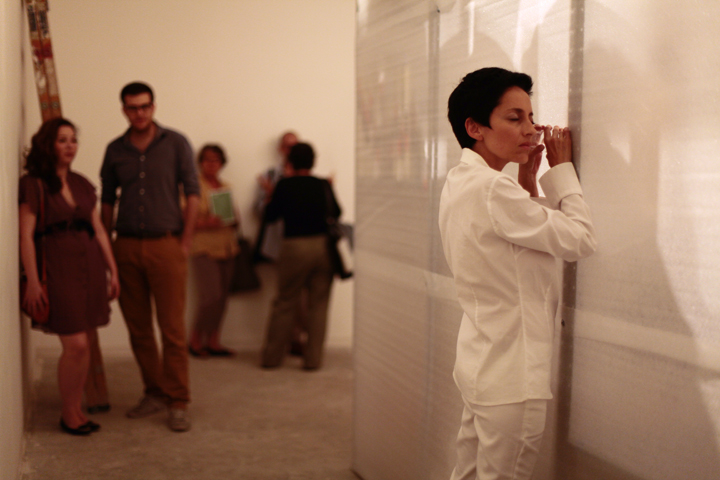
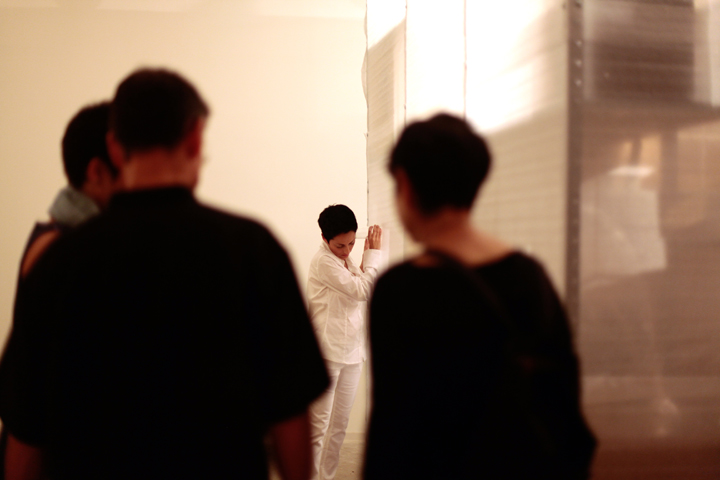
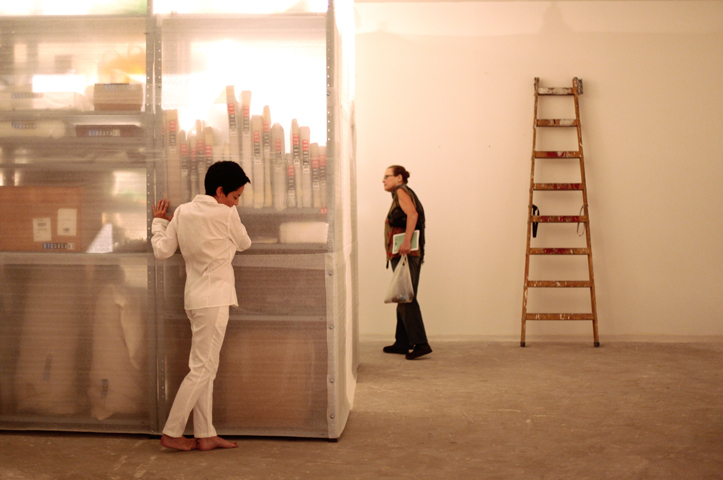
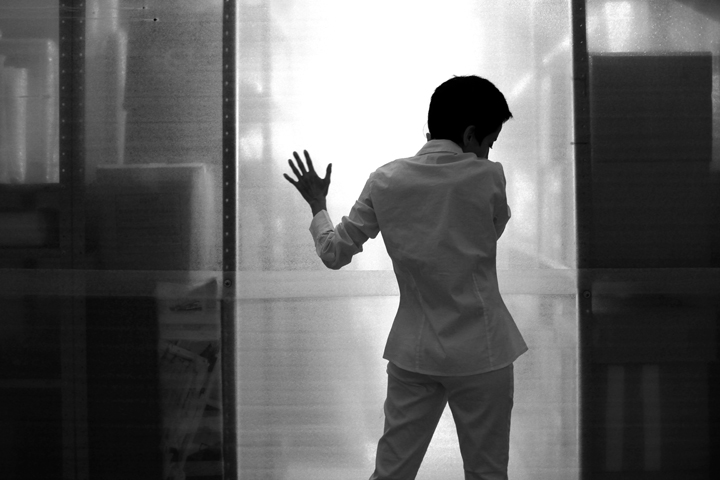
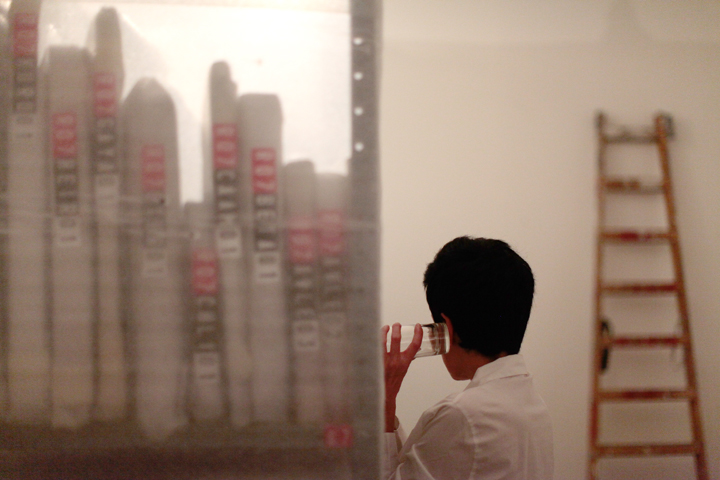







Arjona was one of the performers chosen by Marina Abramovic for The Artist Is Present, her retrospective exhibition at MoMA in New York in 2010. As part of the preliminary work towards this exhibition, Abramovic and Arjona jointly presented the workshop Cleaning the House. In 2009, she was an artist-in-residence at the Robert Wilson ?s Watermill Arts Center, and has staged performances at major museums and venues in South America, the US and Europe before and since.
In addition, over their residency, which included a stay in Tel Aviv and in Jerusalem, they met with local artists, curators and art collectors, and visited many exhibitions and museums. Architect Liya Kohavi gave them an International style tour in Tel Aviv; In Jaffa Lopez visited product designer Yaacov Kaufman studio, and their tour of the Galilee was led by renowned printmaker Orit Hofshi.
Their visit was part of the Irregular Hexagon program, wherein six Colombian artists are hosted by six institutions in Morocco, Israel, Australia, Turkey, Singapore and Vietnam, and produce an exhibition related to their stay. The exhibitions, which follow three-week residencies (each participating institution hosts two artists every year), gives the artists a unique opportunity to engage with the local context, its cultural particularities, its language and its images. López and Arjona, who had previously stayed in Singapore, said that traveling together gave them a rich opportunity to process their impressions with someone who comes from a shared context, and significantly deepened their experience.
Tell Me a Story Because I Can’t Sleep
2011
Long durational performance
For this performance, which Arjona staged for three weeks during opening hours at the New Museum of Contemporary Art, New York, she had collected a great number of individual stories from people all around the world. Over three weeks, Arjona whispered these stories, which she had learned by heart, to one visitor at a time throughout the day. Listeners thus became vessels for the stories they had received, this time second-hand, in a process that evoked storytelling and oral tradition.
Arjona collected the stories via email, Skype, Facebook and personal sessions in Napoli, Bogota and New York, but chose to transfer what she had received using no technological aids. The performance took place in an exhibition called About Face, which was part of the No Longer Empty project.
Arjona placed the original audio recorders of the stories she collected in the gallery space, but these remained a silent testimony. The work offered a crystallized experience of the oral tradition, with our growing dependence on our developing technological mnemonic aids as a background. Arjona challenged the domination of the technological paradigm by choosing singular human interactions and personal memorization as a means to transfer the stories. It is only through such interactions that her collected materials are passed on, in a fragile process of continuous change. According to Arjona, information, when transferred in this manner, retains only what is relevant at the time of its delivery.
The artist raises similar questions regarding her own works. She avoids showing any documentation of her performances and insists that the only legitimate ongoing remnant of a performance is the experience of individuals, not an object. With this stance, Arjona enters the current discourse regarding the economics of performance, and offers a position no less radical than that of German-British artist Tino Sehgal, who sells "constructed situations" to museums and collections with a strict injunctions that there should be no documentation of his works. Arjona's Tell Me a Story can be understood here as a proposal regarding the documentation of performance works, and a reminder of the seemingly forgotten historical and cultural secret of oral storytelling.
The performance is the final piece in a series of works called Vires, which examines social power arrangements. Vires was created after Arjona was among the re-performers in Marina Abramovic's The Artist is Present at MoMA in 2010. Like Abramovic, Arjona exposes the power of the gallery visitor, and turns him or her into an active participant who is left with the choice of whether and how to pass on the story he or she received.
The Simple Balance of Things
2012
Site specific performance
BAAD Gallery, Bezalel Academy of Art and Design, Tel Aviv
In the course of her JCVA residency, Arjona was invited to stage an "intervention" in the BAAD Gallery's temporary archive, which includes some 400 works on loan, arranged on metal shelving. She chose to combine these shelved works into a large (4/4/4m) cube at the center of one of the gallery's spaces. The cube was covered with a partially transparent insulating wrap, normally used to protect such works, so that it was externally uniform in color and texture, but vague images of the works within were still hazily visible.
Arjona's performance involved her walking very slowly and repetitively around the white cube again and again with her eyes shut, while holding a drinking glass to the cube and listening to it intently. This process went on for the entire opening night, some five hours, while crowds continually swept through the gallery. The artist maintained her focus and internal concentration throughout, thus creating yet another partially transparent wrapping both for the works and for herself. Despite the physical proximity, Arjona's performance formed a veil between herself and the audience, a metaphor for her own distance from the local, unfamiliar works in the BAAD archive.
The white cube Arjona created is of course a reflection of the white cube of the gallery itself. Her movement – barefoot in a white suite -- was delimited by two sets of white partitions, the gallery's bare walls and the narrow divider she created between herself and the works collected in the cube. The intensely private and intimate listening ritual, a delicate and precisely performed attempt to get close to the works, offered a thorough contrast to the public dimension of the exhibition.
?Arjona made symbolic use of a connective object, the drinking glass, to mediate between herself and the archived works. She pressed the glass to her ear, and appeared to be listening to the sound coming from the cube's interior. As an artist who uses audio notes for documentation, she relates to sound as a creative source which enlarges the horizons of memory preservation. Unlike the earlier work described above (Tell Me a Story Because I Can’t Sleep), which avoided all visuals besides the silent references to sound recordings, this performance makes the aural quest and the wish to understand – both visual materials, and more -- through sound visually palpable.
The performance, which suggested that silent objects can be listened to intently, and might have a pulse one should attend to, created an island of silence in the tumultuous opening, what Arjona calls a field of energy generated by and surrounding the body in action.
In accordance with Arjona's approach, which does not include any visual documentation of her performances, the video above, filmed and edited by artist Tom Porat was seen by Arjona not as a documentation, but as an independent and fresh work of art, made in response to her own.